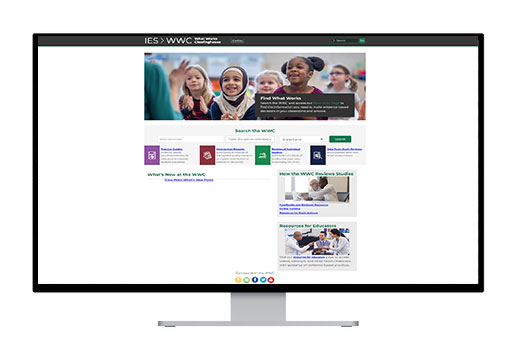Teach For America (TFA) is a highly selective route to teacher certification that aims to place non-traditionally trained teachers in high-need public schools. Many TFA teachers hold bachelors’ degrees from selective colleges and universities, in fields outside of education. TFA teachers commit to teach for at least 2 years. TFA teachers receive 5–7 weeks of in-person training over the summer before they begin teaching, then continue to receive professional development and one-on-one coaching from TFA while teaching, in addition to support provided by their schools and districts. As full-time employees of the public schools where they work, TFA teachers receive the same salary and benefits as other first- or second-year teachers in their school or district.
Clearinghouse and Evidence Level
What Works Clearinghouse
The What Works Clearinghouse (WWC) is an investment of the Institute of Education Sciences (IES) within the U.S. Department of Education that was established in 2002. The work of the WWC is managed by a team of staff at IES and conducted under a set of contracts held by several leading firms with expertise in education, research methodology, and the dissemination of education research, including Abt Associates, American Institutes for Research, Development Services Group, Inc., and Mathematica. Each WWC contract focuses on furthering the goals of the WWC. Information about active WWC contract work can be found on the “WWC Content Teams” page. Visit the “What We Do” section of the WWC website to learn more about the type of work happening at the WWC.
Level 1
Strong evidence from at least one well-designed and well-implemented experimental study.
Quick Stats
Content Focus Area
Curriculum, Instruction, and Assessment
Grade Band
Elementary School; Middle School; High School
Number of studies
7
Intervention Information
The information below provides details and characteristics of the intervention. The presented information is sourced from another clearinghouse. To learn more about the intervention, click through to the Source clearinghouse.
This page displays information on the population and settings in which studies were conducted on the intervention’s effectiveness. This means that the intervention has some level of positive evidence in the listed student populations and context. Remember to take your school’s context and population into consideration when selecting an intervention. Read more on selecting interventions.
| Resource Type | Program Evaluation | This presents the grade level of students represented in the reviewed studies for this intervention. On the OEBC, grade bands are categorized into four levels: Early Childhood (Birth-Age 5), Elementary School (Grades K-5), Middle School (Grades 6-8), and High School (Grades 9-12). |
|---|---|---|
| Subject Area | English Language, Math, Science, Social Studies | This refers to the school subjects: English Language Arts, Math, Science, and Social Studies. An intervention will be tagged with a subject if a reviewed study by the source clearinghouse has found that the intervention led to positive results in learning in that subject. |
| Setting |
|
This presents the setting represented in the reviewed studies for this intervention. On the OEBC, setting has three categories: Rural, Urban, and Suburban. |
| Demographic |
| Demographic information refers to the student’s race/ethnicity and gender. It also includes information on subpopulations (e.g. Students with Disabilities, English Learners, Economically Disadvantaged, Justice Involved, and Foster Care). On the OEBC, an intervention is only tagged with demographic information if that intervention is specifically designed for, and has been reviewed on, that demographic. Please click through to the source clearinghouse to find total demographic breakdowns of all students who have taken part in a study on the intervention. |
| Training Needed | Listed | This indicates if the source clearinghouse has information on training needed to implement the intervention. | Length of Program or Delivery | Listed | This indicates if the source clearinghouse has information on how long the intervention takes to implement (e.g. session delivery time and/or how many days or weeks it takes to implement). |
| Cost | Listed | This indicates if the source clearinghouse has information on the cost to implement the intervention. |
| Effect Size | Listed | This indicates if the source clearinghouse provides an effect size for the intervention. Please visit the source clearinghouse to find the effect size and read more about the studies on this intervention. |
Studies Cited
- Clark, M. A., Chiang, H. S., Silva, T., McConnell, S., Sonnenfeld, K., Erbe, A., & Puma, M. (2013). The effectiveness of secondary math teachers from Teach For America and the Teaching Fellows programs (NCEE 2013-4015). Washington, DC: National Center for Education Evaluation and Regional Assistance, Institute of Education Sciences, U.S. Department of Education. http://files.eric.ed.gov/fulltext/ED544171.pdf.
- Clark, M. A., Isenberg, E., Liu, A. Y., Makowsky, L., & Zukiewicz, M. (2015). Impacts of the Teach for America Investing in Innovation scale-up. Princeton, NJ: Mathematica Policy Research. Retrieved from http://www. mathematica-mpr.com.
- Glazerman, S., Mayer, D., & Decker, P. (2006). Alternative routes to teaching: The impacts of Teach for America on student achievement and other outcomes. Journal of Policy Analysis and Management, 25(1), 75–96.
- Henry, G. T., Purtell, K. M., Bastian, K. C., Fortner, C. K., Thompson, C. L., Campbell, S. L., & Patterson, K. M. (2014). The effects of teacher entry portals on student achievement. Journal of Teacher Education, 65(1), 7–23.
- Turner, H. M., Goodman, D., Adachi, E., Brite, J., & Decker, L. E. (2012). Evaluation of Teach For America in Texas schools. San Antonio, TX: Edvance Research, Inc.
- Ware, A., LaTurner, R. J., Parsons, J., Okulicz-Kozaryn, A., Garland, M., & Klopfenstein, K. (2011). Teacher preparation programs and Teach for America research study. Dallas: Education Research Center, The University of Texas at Dallas.
- Xu, Z., Hannaway, J., & Taylor, C. (2011). Making a difference? The effects of Teach For America in high school. Journal of Policy Analysis and Management, 30(3), 447–469.

